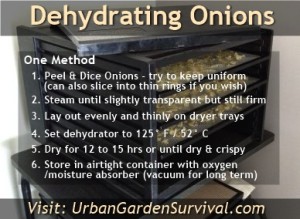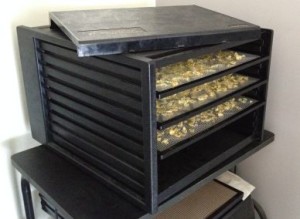Step by Step Dehydrating Food
An introduction to drying your own fresh food
 Dehydrating food is something that I am keen to learn more about. It opens up a whole new world where you can store fresh produce and even make up your own camping recipes… If this is something you would also like to do, then you need to just make a start and that’s what I wanted to do here… Help people make a start!
Dehydrating food is something that I am keen to learn more about. It opens up a whole new world where you can store fresh produce and even make up your own camping recipes… If this is something you would also like to do, then you need to just make a start and that’s what I wanted to do here… Help people make a start!
Generalized articles and recipes are fine, but sometimes you really just need some basic information that breaks a process down into doable steps. It’s also helpful to learn more than one technique for drying foods. Here’s a how-to guide for drying foods step by step, focusing on fruits and vegetables.
You will need to look up specific instructions for each specific food you are wanting to dry, however, have a read through these steps before embarking on your venture, to get a general idea of the process and some tips I have discovered…
Step 1: Obtain Your Produce
Ok… so this probably goes without saying…
Your produce may come from your own garden, a friend/neighbor’s garden, a local farmers’ market, grocery store, etc. The main thing is that you have fresh produce that is at its peak. Even though you’ll be drying it, you don’t want shriveled, dried-up produce to start with.
(However, fruit that is somewhat overripe can still be dried if you use it to make fruit leather.)
Look for fruits and vegetables that do not have soft or mushy spots, and avoid hard, green, under-ripe fruit as well. The food does not have to look perfect; it just needs to be ripe and free of decay.
Step 2: Prepare Your Produce – Wash and Blanch
If possible, obtain your produce and dry it on the same day. Wash it well and pat it dry.
 Some foods can be dried without blanching, however, others will need to be blanched or will dry a lot quicker if blanched first.
Some foods can be dried without blanching, however, others will need to be blanched or will dry a lot quicker if blanched first.
To blanch your produce, bring a large pot of water to a boil and fill a large bowl or pot with ice water. You will also need a slotted spoon or steamer basket to get the produce out of the water quickly. You are preparing to blanch your produce – dip it quickly in boiling water, and then plunge it in cold water to stop the cooking.
Sources recommend that you do not skip this step, because it will make all the difference in the quality and shelf life of your foods. This is because blanching kills bacteria that cause decay. The exceptions to the blanching rule are mushrooms, which should just be wiped clean, and bananas, which will soften too much in boiling water.
Blanch vegetables for 3-5 minutes and fruits for 2-3 minutes.
Step 3: Pat Dry and Spread on Drying Sheets
After blanching, place your produce on trays or cookie sheets, cover with several layers of paper towels, and then pat it dry.
Step 4: Slice and Cut Food
Slice fruits like strawberries, bananas, pineapples and apples into thin slices. Cut corn kernels off the cob. Halve stone fruits and remove the stones (pits).
Step 5: Place Food in Dehydrator (if you don’t have one, skip to Step 6)
Place the food on the dryer trays with space between the pieces with no overlaps (for some things, like chopped onions having overlap won’t be a problem). Turn the dehydrator to the setting recommended by the manufacturer, set your timer.
If you don’t have a Dehydrator machine…
Step 6: OR Place Food on Cloth-Covered Screens or String with Thread
Using old window screens (as long as they are lead-free) is fine, and so is stapling screening to a plain wood frame. Cover with cloth, place food on the cloth (close together but not touching), and cover with another cloth. Place outside in a dry, shady area and bring in at night (before any dew settles). Repeat for several days.
[Reminds me of years ago when I was living on a farm, we had large tray’s with screen, and would cut up fruit; apricots, peaches, plums etc. and put out on timber stands in the sun to dry…]
[rectanglebox id=4]
If you string your food on thread, as with green beans or whole, small mushrooms, you’ll need to hang it in a dry, shady area as well and bring it inside at night. Both methods can be done indoors in a dry attic, as well.
So there are a few dehydrating tips to hopefully get you started… it is really not all that difficult, and when you have your own freshly dehydrated food then there is a whole new set of lessons… How to store it short and long term, how you can use these foods in dry mixes etc.
One other thing I would also be interested in, is learning more about dehydrating already prepared meals…
Maybe another day 🙂
Leave a Reply